Radar
From Signal Identification Wiki
Description[edit]
Radar signals are emissions from various radars, including aircraft radars, over the horizon radars, oceanic radars, and atmospheric radars.
Click the name of a signal to see more detailed information and additional sound and waterfall samples
| Inactive (No longer in use) |
Active (Currently in active use) |
Status Unknown or Intermittent |
| Signal Name | Description | Frequency | Mode | Modulation | Bandwidth | Location | Sample Audio | Waterfall image |
|---|---|---|---|---|---|---|---|---|
| 'Ghadir' OTH Radar | 'Ghadir', is an Iranian over the horizon radar, part of Iran's Sepehr Phased Radar System. | 28 MHzMegaHertz (MHz) 10^6 Hz — 29.7 MHzMegaHertz (MHz) 10^6 Hz | AMAmplitude Modulation | Pulse | 60 kHzKiloHertz (kHz) 10^3 Hz — 1 MHzMegaHertz (MHz) 10^6 Hz | Iran | 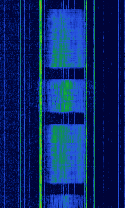 |
|
| 'OTH-SW' OTH Radar | OTHOver The Horizon (very long range)-SW is a Chinese over-the-horizon radar. It is known to operate with pulse repetition frequencies of 43 HzHertz (Hz), unit of frequency, defined as one cycle per second (1 Hz). and 86 HzHertz (Hz), unit of frequency, defined as one cycle per second (1 Hz).. | 6 MHzMegaHertz (MHz) 10^6 Hz — 30 MHzMegaHertz (MHz) 10^6 Hz | USBUpper Side Band Modulation (Radio, referring to reception and modulation mode)Universal Serial Bus (Computer, referring to USB Ports and cables) | FMCW | 40 kHzKiloHertz (kHz) 10^3 Hz — 80 kHzKiloHertz (kHz) 10^3 Hz | China | 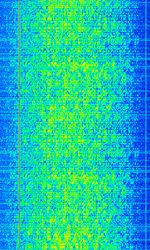 |
|
| 29B6 'Kontayner' OTH Radar | 29B6, nicknamed 'Контейнер' (Kontayner), is a Russian over the horizon radar. It is currently very active in Europe. The radar uses 150 antenna masts with data transmission systems, transmitters and receivers, a power station, and control buildings. It can detect high-altitude and low-altitude aircraft and missiles at very long ranges. | 6.1 MHzMegaHertz (MHz) 10^6 Hz — 32 MHzMegaHertz (MHz) 10^6 Hz | USBUpper Side Band Modulation (Radio, referring to reception and modulation mode)Universal Serial Bus (Computer, referring to USB Ports and cables) | FMOP, Pulsed | 3.5 kHzKiloHertz (kHz) 10^3 Hz — 28 kHzKiloHertz (kHz) 10^3 Hz | Russia | 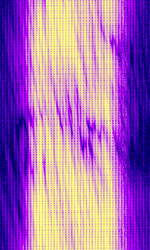 |
|
| 77Ya6 'Voronezh' radar | Voronezh (Воронеж) is a Russian radar family capable of aircraft and ballistic missile monitoring. | 150 MHzMegaHertz (MHz) 10^6 Hz — 440 MHzMegaHertz (MHz) 10^6 Hz | AMAmplitude Modulation | FMCW | 2 MHzMegaHertz (MHz) 10^6 Hz | Russia |  |
|
| CODAR | CODAR (Coastal Ocean Dynamics Applications Radar) is used for near-surface ocean monitoring, such as waves and water current. | 4.438 MHzMegaHertz (MHz) 10^6 Hz — 42.5 MHzMegaHertz (MHz) 10^6 Hz | USBUpper Side Band Modulation (Radio, referring to reception and modulation mode)Universal Serial Bus (Computer, referring to USB Ports and cables) | ILFM | 50 kHzKiloHertz (kHz) 10^3 Hz | Worldwide | 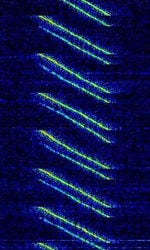 |
|
| Canadian Meteor Orbit Radar (CMOR) | Canadian Meteor Orbit Radar, or CMOR, is a meteor detection radar located near Tavistock, Ontario. | 17.45 MHzMegaHertz (MHz) 10^6 Hz — 38.15 MHzMegaHertz (MHz) 10^6 Hz | AMAmplitude Modulation | Pulsed | 28 kHzKiloHertz (kHz) 10^3 Hz | Canada | 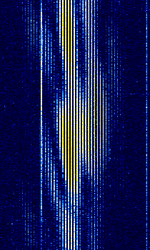 |
|
| Chinese 'Foghorn' OTH radar | A Chinese over the horizon radar, known as "foghorn" among amateur radio operators. Not much is known about it. | 6 MHzMegaHertz (MHz) 10^6 Hz — 29 MHzMegaHertz (MHz) 10^6 Hz | USBUpper Side Band Modulation (Radio, referring to reception and modulation mode)Universal Serial Bus (Computer, referring to USB Ports and cables) | FMCW | 10 kHzKiloHertz (kHz) 10^3 Hz | China, Worldwide | 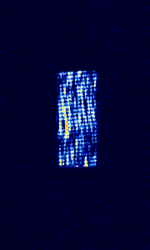 |
|
| Chinese 160kHz-wide OTH radar | Chinese OTHOver The Horizon (very long range) radar with wide bandwidth and usually low sweep rate. Little information is available. | 6 MHzMegaHertz (MHz) 10^6 Hz — 29 MHzMegaHertz (MHz) 10^6 Hz | USBUpper Side Band Modulation (Radio, referring to reception and modulation mode)Universal Serial Bus (Computer, referring to USB Ports and cables) | FMCW | 160 kHzKiloHertz (kHz) 10^3 Hz | China | 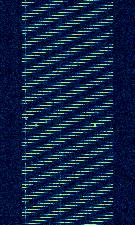 |
|
| Cobra Dane | The AN/FPS-108 COBRA DANE is a PESA phased array radar installation operated by Raytheon for the United States Space Force (originally for the United States Air Force) at Eareckson Air Station on the island of Shemya, Aleutian Islands, Alaska. | 1,215 MHzMegaHertz (MHz) 10^6 Hz — 1,400 MHzMegaHertz (MHz) 10^6 Hz | United States | — |  |
|||
| Digisonde | Digisondes are ionosondes that use pulsed signal that can gather more radar information than a traditional ionosonde sweep. | 500 kHzKiloHertz (kHz) 10^3 Hz — 30 MHzMegaHertz (MHz) 10^6 Hz | RAW | Pulsed | 30 kHzKiloHertz (kHz) 10^3 Hz | Worldwide | 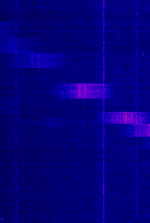 |
|
| Duga 3 | Duga (Russian: Дуга́) was a Soviet over-the-horizon radar system used as part of the Soviet missile defense early-warning radar network. The system operated from July 1976 to December 1989. Two operational Duga radars were deployed, one near Chernobyl and Chernihiv in the Ukrainian SSR (present-day Ukraine), the other in eastern Siberia. The Duga systems were extremely powerful, over 10 MW in some cases, and broadcast in the shortwave radio bands. They appeared without warning, sounding like a sharp, repetitive tapping noise at 10 HzHertz (Hz), unit of frequency, defined as one cycle per second (1 Hz)., which led to it being nicknamed by shortwave listeners the Russian Woodpecker. | 7 MHzMegaHertz (MHz) 10^6 Hz — 19 MHzMegaHertz (MHz) 10^6 Hz | 20 kHzKiloHertz (kHz) 10^3 Hz — 800 kHzKiloHertz (kHz) 10^3 Hz | Ukraine | 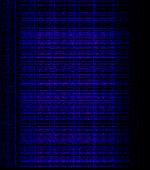 |
|||
| GRAVES | The Grand Réseau Adapté à la Veille Spatiale (GRAVES) system is a French space-surveillance system for low-orbit (up to 1000km) satellites. Emitter is based near Dijon, France. | 143.05 MHzMegaHertz (MHz) 10^6 Hz | RAW I/Q | 1 kHzKiloHertz (kHz) 10^3 Hz | France | 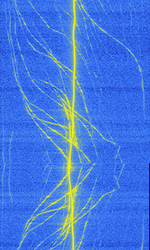 |
||
| High Frequency Active Auroral Research Program (HAARP) | HAARP is a ionospheric research program conducted in Gakona, Alaska. | 2.7 MHzMegaHertz (MHz) 10^6 Hz — 10 MHzMegaHertz (MHz) 10^6 Hz | AMAmplitude Modulation, CWContinuous Wave | CWContinuous Wave, FMCW | 100 kHzKiloHertz (kHz) 10^3 Hz | United States | 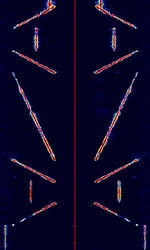 |
|
| High Power Auroral Stimulation (HIPAS) | The HIPAS (HIgh Power Auroral Stimulation) Observatory was a research facility, built to study the ionosphere and its influence on radio communications. It was located 25 miles east of Fairbanks, Alaska in the Fairbanks North Star Borough area. | 2.85 MHzMegaHertz (MHz) 10^6 Hz — 4.53 MHzMegaHertz (MHz) 10^6 Hz | United States | — |  |
|||
| Ionosonde | An Ionosonde (Also known as a chirpsounder or ionospheric sounder) is a radar that examines the Ionosphere and monitors HFHigh Frequency (3-30 MHz) propagation conditions by sweeping the HFHigh Frequency (3-30 MHz) band and receiving the echoes. | 1 MHzMegaHertz (MHz) 10^6 Hz — 40 MHzMegaHertz (MHz) 10^6 Hz | USBUpper Side Band Modulation (Radio, referring to reception and modulation mode)Universal Serial Bus (Computer, referring to USB Ports and cables) | FMCW | 1 HzHertz (Hz), unit of frequency, defined as one cycle per second (1 Hz). | Worldwide | 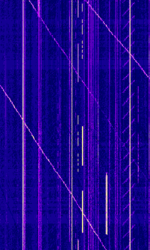 |
|
| Jindalee Operational Radar Network (JORN) | JORN is an Australian OTHR system that operates uniquely in that it's radar bursts include an intro tone before the burst. | 5.7 MHzMegaHertz (MHz) 10^6 Hz — 33 MHzMegaHertz (MHz) 10^6 Hz | USBUpper Side Band Modulation (Radio, referring to reception and modulation mode)Universal Serial Bus (Computer, referring to USB Ports and cables) | FMCW | 3 kHzKiloHertz (kHz) 10^3 Hz — 60 kHzKiloHertz (kHz) 10^3 Hz | Australia | 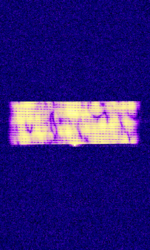 |
|
| PLUTO II OTH Radar | PLUTO II is an Over The Horizon Radar located in the Sovereign Base Area just outside RAF Akrotiri in Cyprus. PLUTO II is very active in Europe. | 8 MHzMegaHertz (MHz) 10^6 Hz — 38 MHzMegaHertz (MHz) 10^6 Hz | USBUpper Side Band Modulation (Radio, referring to reception and modulation mode)Universal Serial Bus (Computer, referring to USB Ports and cables) | FMCW | 20 kHzKiloHertz (kHz) 10^3 Hz — 40 kHzKiloHertz (kHz) 10^3 Hz | Cyprus | 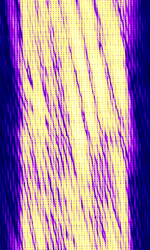 |
|
| Podsolnukh 'Sunflower' Radar | A Russian over the horizon radar, also known as "Sunflower" | 3.5 MHzMegaHertz (MHz) 10^6 Hz — 8 MHzMegaHertz (MHz) 10^6 Hz | IQQuadrature signals form the basis of complex RF signal modulation and demodulation, both in hardware and in software, as well as in complex signal analysis. | FMOP | 50 kHzKiloHertz (kHz) 10^3 Hz | Russia, Worldwide | 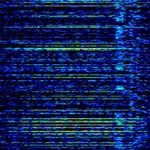 |
|
| Primary Aeronautical Surveillance Radar | A Primary radar (PSR Primary Surveillance Radar) is a conventional radar sensor that illuminates a large portion of space with an electromagnetic wave and receives back the reflected waves from targets within that space. | 1,215 MHzMegaHertz (MHz) 10^6 Hz — 1,400 MHzMegaHertz (MHz) 10^6 Hz | RAW | Pulse | 3 MHzMegaHertz (MHz) 10^6 Hz | Worldwide | 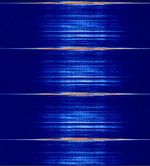 |
|
| Radar altimeter | Aircrafts radar altimeter. | 4,200 MHzMegaHertz (MHz) 10^6 Hz — 4,300 MHzMegaHertz (MHz) 10^6 Hz | AMAmplitude Modulation | FMCW | 20 MHzMegaHertz (MHz) 10^6 Hz | Worldwide |  |
|
| Relocatable Over-the-Horizon Radar (ROTHR) | Relocatable Over-the-Horizon Radar (ROTHR), also known as AN/TPS-71, is an OTHOver The Horizon (very long range) Radar used by the United States Navy that uses bistatic ionospheric backscattering for wide area surveillance. | 5 MHzMegaHertz (MHz) 10^6 Hz — 28 MHzMegaHertz (MHz) 10^6 Hz | USBUpper Side Band Modulation (Radio, referring to reception and modulation mode)Universal Serial Bus (Computer, referring to USB Ports and cables) | FMCW | 4 kHzKiloHertz (kHz) 10^3 Hz — 100 kHzKiloHertz (kHz) 10^3 Hz | United States | 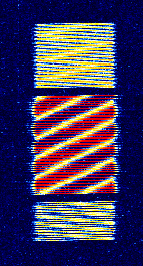 |
|
| Russian OTH 'Ghadir' type | Over The Horizon radar with a very similar signal structure as Ghadir. Operating in west Russia. | 28.6 MHzMegaHertz (MHz) 10^6 Hz | USBUpper Side Band Modulation (Radio, referring to reception and modulation mode)Universal Serial Bus (Computer, referring to USB Ports and cables) | Russia |  |
|||
| SIMONe meteor radar | The SIMONe radar is a meteor detection system that is operated in multiple research sites around the world. It uses continuous spread-spectrum coded transmissions which gives it an unusual sound when demodulated into audio. It can be received over long distances during sporadic-E and other special propagation conditions. | 32.55 MHzMegaHertz (MHz) 10^6 Hz | AMAmplitude Modulation | PSKPhase-Shift Keying, DSSS | 140 kHzKiloHertz (kHz) 10^3 Hz | Worldwide | 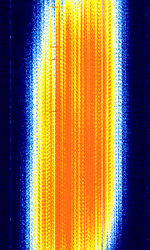 |
|
| SKiYMET meteor radar | SKiYMET is a meteor detection radar which is used by many research institutes around the world. It can use different transmission parameters and can be received over long distances during sporadic-E and other special propagation conditions. | 29 MHzMegaHertz (MHz) 10^6 Hz — 40 MHzMegaHertz (MHz) 10^6 Hz | AMAmplitude Modulation | Pulsed | 160 kHzKiloHertz (kHz) 10^3 Hz | Worldwide | 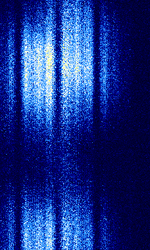 |
|
| Secondary surveillance radar (SSR) | Secondary surveillance radar (SSR)is a radar system used in air traffic control. A surveillance radar system which uses transmitters/receivers (interrogators) and transponders. | 1,030 MHzMegaHertz (MHz) 10^6 Hz | RAW | PPMPulse Position Modulation | 3 MHzMegaHertz (MHz) 10^6 Hz | Worldwide | 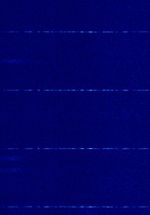 |
|
| SuperDARN (Super Dual Auroral Radar Network) | SuperDARN (Super Dual Auroral Radar Network) is an international radar network used for scientific purposes. The network is used to study plasma convection in the upper atmosphere. | 9 MHzMegaHertz (MHz) 10^6 Hz — 16 MHzMegaHertz (MHz) 10^6 Hz | USBUpper Side Band Modulation (Radio, referring to reception and modulation mode)Universal Serial Bus (Computer, referring to USB Ports and cables) | PPMPulse Position Modulation | 6 kHzKiloHertz (kHz) 10^3 Hz | Worldwide | 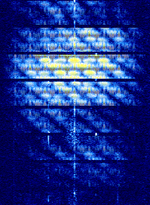 |
Pages in category "Radar"
The following 35 pages are in this category, out of 35 total.